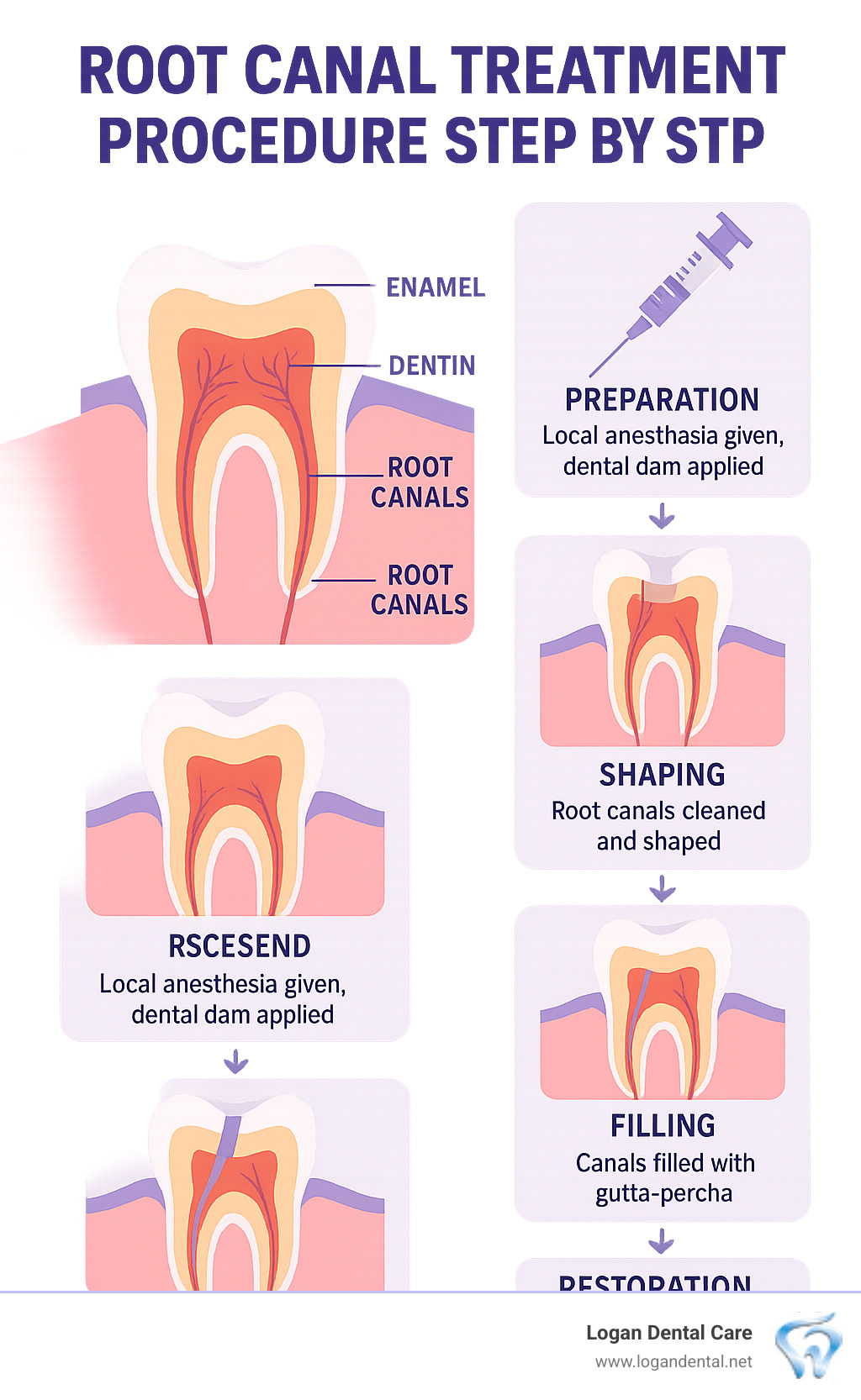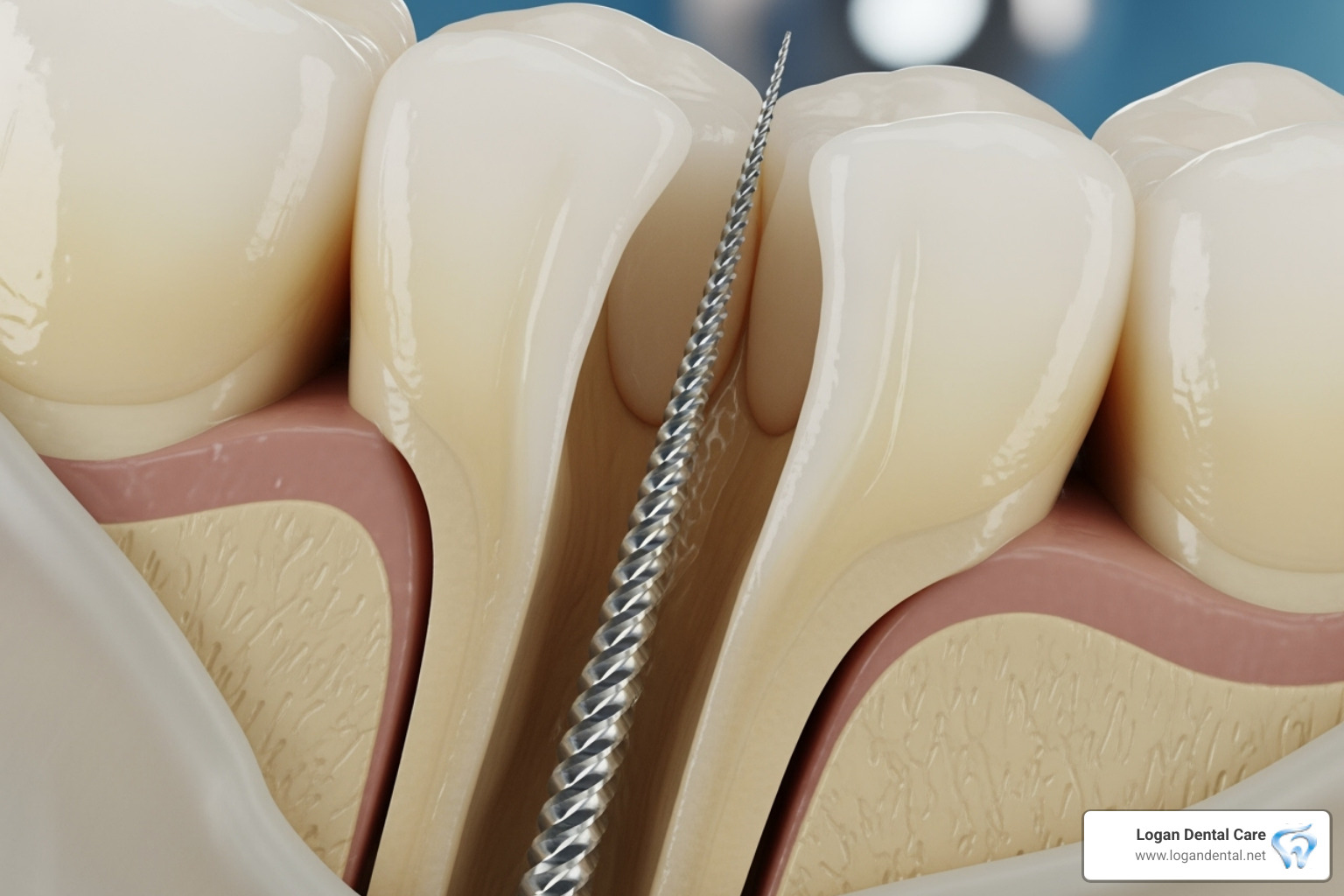The Root of the Matter: How a Root Canal Saves Your Tooth

Understanding Root Canal Treatment: Your Complete Guide
Root canal treatment procedure step by step involves removing infected pulp, cleaning and shaping the canals, then filling and sealing the tooth to save it from extraction. This common dental procedure treats more than 15 million teeth each year and has a success rate up to 90%.
Here's the essential root canal treatment procedure step by step:
- Preparation - Local anesthesia numbs the area, dental dam isolates the tooth
- Access and Cleaning - Dentist creates opening, removes infected pulp with tiny instruments
- Shaping - Root canals are cleaned and shaped with antibacterial solutions
- Filling - Canals filled with gutta-percha and sealed with cement
- Restoration - Temporary filling placed, permanent crown added later
If you're dealing with severe tooth pain, swollen gums, or sensitivity to hot and cold, you might be wondering what exactly happens during this tooth-saving procedure. The good news? Modern root canal treatment is far less intimidating than old stories suggest.
Root canal therapy actually relieves pain rather than causing it. Most procedures take 60-90 minutes and feel similar to getting a large filling. With proper anesthesia, you'll be comfortable throughout the process.
At Logan Dental Care, we understand that busy professionals need clear information to make informed decisions about their dental health. That's why we're breaking down each step of this proven procedure that has helped millions keep their natural teeth.

Why a Root Canal is a Tooth-Saving Solution
Deep inside your tooth is a soft tissue called pulp, containing nerves and blood vessels. While vital for a growing tooth, a mature tooth can survive without it, getting nourishment from surrounding tissues.
When this inner pulp becomes infected or inflamed, a root canal becomes your tooth's best hope for survival.
What is Endodontic Therapy and Why is it Performed?
Endodontic therapy—the clinical name for root canal treatment—is needed when the tooth's pulp becomes infected. Infection can start from deep decay or a cracked tooth, allowing bacteria to reach the pulp. If untreated, this can lead to a painful abscess, a pocket of pus that can pose a serious health risk.
The root canal treatment procedure step by step saves the tooth by removing the infected pulp, cleaning the inner chambers, and sealing it. This allows you to keep your natural tooth.
Saving natural teeth is far better than extraction. It prevents other teeth from shifting, preserves your jawbone, and maintains your natural bite and speech. With success rates up to 90%, modern root canals are routine, comfortable procedures that relieve pain, not cause it. Most patients compare the experience to getting a large filling.
For a detailed comparison, see our Root Canal vs. Extraction guide. You can also learn more about the dental pulp from scientific resources.
Common Signs You Might Need a Root Canal
Your body often signals when a tooth's pulp is in trouble. Look for these common signs:
- Severe, persistent toothache, especially when lying down.
- Sharp pain when chewing or applying pressure.
- Lingering sensitivity to hot or cold temperatures that lasts after the source is removed.
- Swollen, tender gums near the affected tooth.
- Tooth discoloration, with the tooth appearing darker or grayish.
- A recurring pimple on the gums, which may release pus from an abscess.
- Radiating pain to the jaw, face, or ear.
At Logan Dental Care, we use dental X-rays to confirm what's happening beneath the surface. If you're experiencing any of these symptoms, especially severe tooth pain in Bellefontaine, OH, it's crucial to seek attention. Learn more about our Root Canal services and get the relief you need.
The Complete Root Canal Treatment Procedure Step by Step
Let's walk through the root canal treatment procedure step by step so you feel fully prepared. Our goal at Logan Dental Care is to combine a small-town, family feel with the latest technology to provide you with comfortable, personalized care.
Step 1: Preparing for the Procedure (Numbing and Isolation)
This first step is all about ensuring your comfort and creating a sterile environment for the procedure.
- Local Anesthesia: We begin by administering a local anesthetic to completely numb the tooth and surrounding gum tissue. You won't feel any pain during the treatment.
- Dental Dam Placement: Once you're numb, we place a thin rubber sheet called a dental dam around the tooth. This isolates it from the rest of your mouth, keeping it clean and dry, and preventing any debris or solutions from being swallowed.

- Procedure Duration: Most root canals take about 60 to 90 minutes. More complex teeth, like molars, might require more time or a second visit.
Step 2: The Core of the Root Canal Treatment Procedure Step by Step (Cleaning and Shaping)
This is where we address the source of the problem by cleaning and disinfecting the inside of your tooth.
- Access and Pulp Removal: We create a small opening in the top of the tooth to access the inner pulp chamber. Using tiny, specialized instruments, we carefully remove the infected or damaged pulp tissue. This step eliminates the source of your pain.

- Cleaning, Shaping, and Irrigation: The inside of the root canals are thoroughly cleaned with an antibacterial solution. We then use a series of small, flexible instruments to shape the canals, preparing them to be filled. Throughout this process, we continuously flush (irrigate) the canals to wash away any remaining bacteria and debris.
Step 3 of the Root Canal Treatment Procedure Step by Step: Filling and Sealing
Once the canals are clean, the final step is to fill and seal them to prevent any future infection.
- Gutta-percha and Sealer Cement: The cleaned canals are filled with a biocompatible, rubber-like material called gutta-percha. It's combined with an adhesive sealer cement to create a tight, hermetic seal from top to bottom.
- Sealing the Access Hole: We place a temporary filling in the access hole to protect the tooth. This will be replaced with a permanent restoration at a follow-up appointment.
This meticulous process is designed to save your tooth and set it up for long-term success. For more on the final restoration, check out our guide. More info about Your Guide to Root Canals and Crowns
Life After Your Root Canal: Recovery, Restoration, and Care
You've successfully completed the root canal treatment procedure step by step, and your tooth is on the path to recovery. The next steps are crucial for ensuring the long-term health of your treated tooth.
The Healing Process and Why a Dental Crown is Crucial
Here's what to expect after your root canal:
- Post-procedure care: It's normal to have some mild sensitivity for a few days, which can be managed with over-the-counter pain relievers. Contact us immediately if you experience severe pain or swelling.
- Eating and hygiene: Stick to soft foods for a few days and chew on the opposite side of your mouth. Continue to brush and floss daily, being gentle around the treated area.
- Follow-up and permanent restoration: The temporary filling is not meant for long-term use. A follow-up appointment to place a permanent restoration, most often a dental crown, is a critical final step.
A dental crown acts like a helmet, protecting the now more brittle tooth from fracturing, restoring its full function for chewing, and providing a final seal against bacteria. At Logan Dental Care, we can create a beautiful, functional Dental Crown to complete your treatment.
For tips on what to eat after your procedure, the Cleveland Clinic offers helpful suggestions. More info on what to eat after oral surgery
Understanding Success Rates and Potential Risks
Root canal therapy has a high success rate of up to 90%, and most treated teeth last a lifetime with proper care. While complications are rare, a root canal can sometimes fail due to complex canal anatomy or new decay. In many of these cases, a retreatment can be performed to save the tooth.
Your long-term success depends on diligent oral hygiene and regular dental check-ups. At Logan Dental Care, we're committed to giving you the best possible outcome. If you're experiencing severe tooth pain in Bellefontaine, OH, learn more about our Root Canal services.
To help you make an informed decision, here's a quick comparison:
| Feature | Root Canal Treatment | Tooth Extraction |
|---|---|---|
| Pros | - Saves your natural tooth. - Prevents teeth from shifting and preserves jawbone. - Maintains your natural bite and appearance. - High success rate (up to 90%). - More cost-effective long-term than replacement. | - Quick removal of the source of pain. - Lower initial cost than a root canal. - Simpler procedure for severely damaged teeth. |
| Cons | - May require multiple visits. - Requires a crown, adding to the cost. - Rare potential for failure, requiring retreatment. | - Permanent loss of a natural tooth. - Can lead to bone loss and shifting teeth. - Creates a gap affecting chewing and appearance. - Replacement (implant, bridge) is costly and requires more procedures. |

